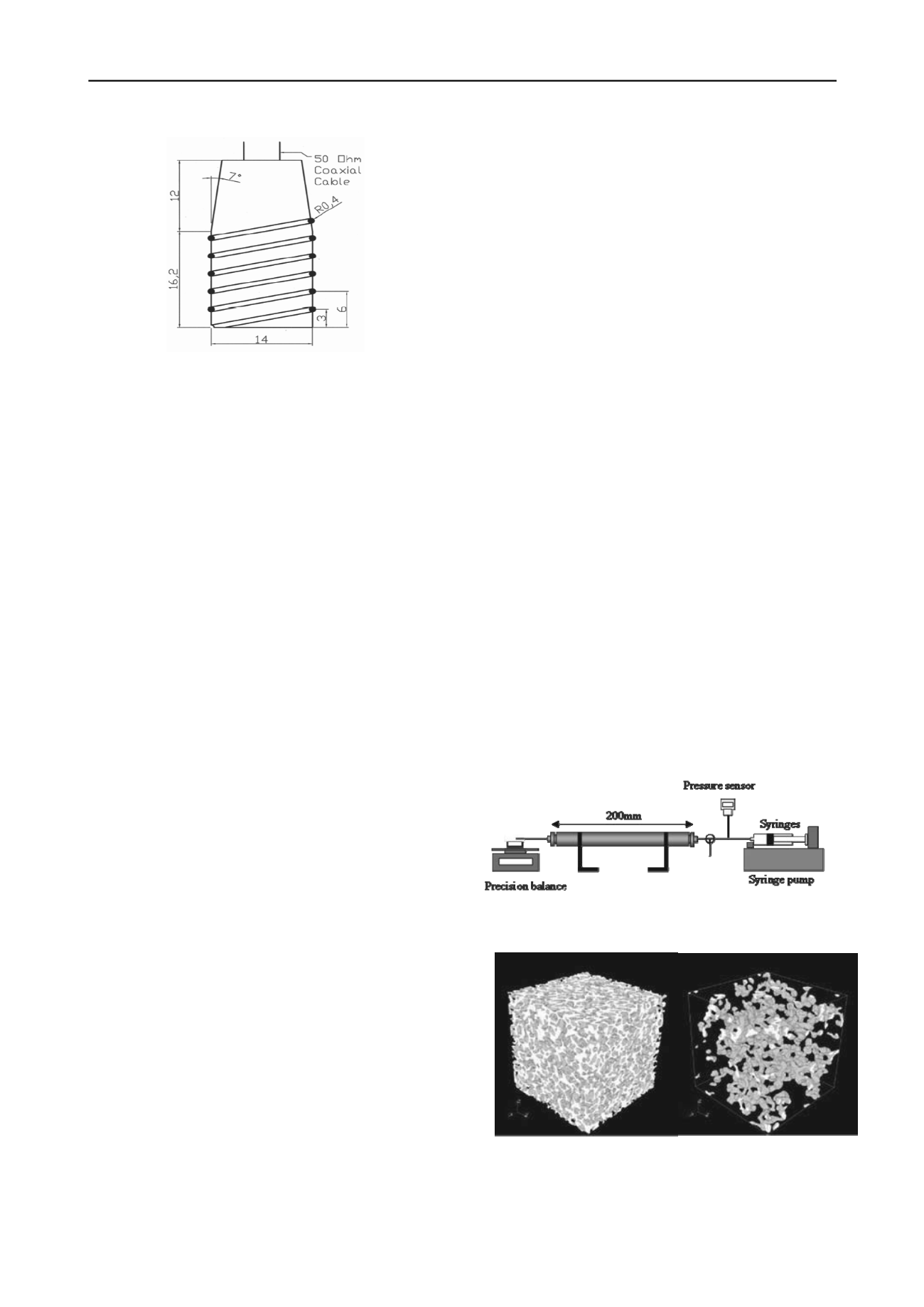
1064
Proceedings of the 18
th
International Conference on Soil Mechanics and Geotechnical Engineering, Paris 2013
Figure 3. Schematic of tensiometer housing and coiled TDR -
dimensions in mm (from
Toll et al.
)
The multi-electrode resistivity system is combined with
automatic multiplexing to exploit a large number of electrodes.
To prevent electrode polarization short pulses and reverse
polarity readings are adopted. Calibration tests demonstrate that
the proposed equipment gives a maximum error of less than 1%
on resistance. The system was used to investigate both drying
and wetting of sandy clay samples from a trial embankment. A
very well defined resistivity-water content relationship was
obtained, with high correlation coefficients, confirming
potentialities of this technique both in the laboratory and in the
field.
The new sensor proposed in the paper, combining suction
and water content measurement in a single probe, appears
extremely promising for accurate simultaneous monitoring of
the two variables, at least in the laboratory. Provided the
interpretation of the data from coiled TDR properly accounted
for the geometry of measurement scheme, the new device shows
an accuracy for water content determination of ±(0.047÷0.075),
already by means of a theoretical model based on mixture
theory, in the absence of direct experimental calibration. The
new probe was tested on different soils, ranging from sand to
clay and organic soil, and performed well in most cases against
conventional 3 prong TDR device.
It is worthwhile remarking that most of previous
experimental data do not allow for an exhaustive picture of the
whole WR domain. On the one hand, still most data are
collected along drying paths only. On the other hand, for those
soils which undergo significant volume change during drying
and wetting, the typical data collected just represent a series of
pictures of water contents at different void ratios. Information
on void ratio at subsequent stages is seldom provided, hence
hindering to a certain extent a comprehensive interpretation of
the retention behaviour, and generalisation of the laboratory
information to different hydraulic paths and history.
Dependence of the WR behaviour on initial state and
hydraulic history is discussed by
Mendes & Toll
(UK) on
remoulded sample of sandy clay of low plasticity. Their results
confirm that the WR domain is affected by mechanical state
parameters especially at low suction values, where the dominant
retention mechanism is capillarity. At decreasing water content,
the amount of water retained inside the soil mostly depends on
the physico-chemical characteristics of the solid phase, and
tends to become independent from the actual void ratio, as
recently discussed by various authors.
At high water ratios suction changes affect significantly both
the hydraulic state and the mechanical state of the soil,
depending on the soil fabric and on the shrinkage-swelling
properties of the soil.
Fredlund & Zhang
(Canada) suggest to
assist the interpretation of water retention data from
conventional equipment – which do not provide usually any
information on void ratio – with simple results from
conventional shrinkage curves. Careful choice of size and
aspect ratio should prevent cracking of the sample during the
test, thus allowing to associate a value of void ratio to each
suction-water content state. Current degree of saturation can be
determined from the pair of data void ratio - water content,
hence allowing re-writing the drying branch of the water
retention curve in terms of degree of saturation as a function of
void ratio too. The procedure suggested may help in better
discriminating between changes in water ratio due to retention
mechanisms from water expulsion due to changing void ratio,
but its applicability is limited to the drying branch of the water
retention domain. Also, the consequences of stress state cannot
be accounted for, as no stress is applied to the drying sample.
The results can therefore be up scaled to the field only for the
upper horizon of the soil, where the effects of stress could be
disregarded.
In spite of all the efforts currently dedicated to suggest new
fast and reliable techniques for characterising the water
retention properties of unsaturated soils, it is worthwhile
observing that data from most experimental techniques are the
result of multiphase flow processes, and that some aspects of
these processes are not fully understood yet.
The work by
Mukunoki & Mikami
(Japan) includes
highlights on one of these aspects, which is the dependence of
the retention properties of porous media on the rate of
convective flux. The study presented by the Authors was aimed
at understanding the mechanism of light non-aqueous phase
liquid (LNAPL) migration in sandy soils. To this aim a new
testing apparatus was conceived, in which fluid is injected in the
sample and the flow is tracked by a micro-focused X-ray
computed tomography scanner (MXCT), as schematically
depicted in Fig. 4. Both inlet and outlet pressure were measured,
as well as the outflowing mass of fluid. The distribution of the
fluid phases was analysed taking into account connectivity of
the 3D pore structure in the elaboration of MXCT data (Fig. 5).
The results show that the distribution of the fluid phases in the
soil pore structure following the induced flow will depend on
the injection rate. The reason for this dependency is that the
local path followed by the injected fluid will change depending
on convective (Darcy) velocity, hence on current hydraulic
conductivity and hydraulic gradient, kinematic viscosity and
interfacial tension.
Figure 4. Schematic of MXCT fluid injection testing set-up (from
Mukunoki & Mikami
)
(a)
(b)
Figure 5. MXCT images of (a) pore structure, and (b) LNAPL residual
distribution (from
Mukunoki & Mikami
)


